In 1606 during the beginning of the Edo Period, Okada Village was created from the three districts of Oku,
Naka, and Sato in Hinagago.
At the time, Okada’s population was 700 people living in 146 houses. It produced 689 Koku
(approx.100,000kg) of rice. As a secondary job, many farmers did weaving.
During 1716-35, Nakashima Shichiemon and Takeuchi Gensuke received a license to sell momen wholesale
in order to extend the market of Chita Momen across the country.
Around 1893, the imported weaving machine started the age of factory productivity.
In 1899, Takeuchi Toraou received a patent for his weaving machine, improving productivity.
In 1928, paved roads changed the town dramatically, and many new cotton factories and stores thrived.
Until 1955 Okada accounted for 70% of cotton productivity in the Chita Peninsula. As the center of the
Chita Momen industry, 3000 female employees worked at the factories in the town. The playhouse Kiraku-za
was built during this golden age.
In 1902, the first post office was built in the town for the female employees from outside of town to send
monies or letters to their families in their home towns. It is the oldest post office in Aichi Prefecture
remaining as it originally existed. (It was licensed as a Registered Tangible Cultural Property in 2012.)
During the spring festival every April, three groups--Oku, Naka, and Sato-show off three festival floats with
deku (wooden doll) and karakuri ningyo (mechanical doll).
Historical places established in 1350 which still exist in the town today include Jiun-ji Temple, Okada Shinmeisya Shrine,
Chita Okada Post Office, Momen warehouse Chita, and Japanese restaurant and ryokan (inn) Masuiso.
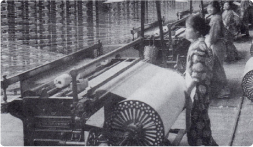
Jyoko-san
(Female workers working at the factory)
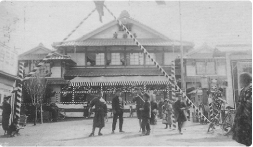
Kirakuza(Playhouse)
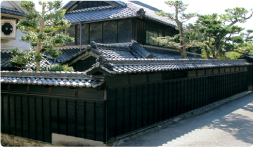
House of Takeuchi Torao
During the beginning of the Edo Period in the Keicho Era (1596-1614), Chita Momen began to be sent to
Edo. Unfinished, un-dyed cotton cloth was sent to Ise where it was refined into Ise-sarashi and
Matsuzaka-sarashi. It was sent on to Edo from Ise.
In the middle of the Edo Period, in the Tenmei Era (1781-88), the sarashi refining technique introduced by
Nakashima Shichiemon and others from Okada successfully popularized Chita Momen. It was marketed as Chita
Sarashi and was considered in Edo to be one of the finest fabrics in all of Japan.
In Chita, in villages which didn't have enough cultivatable land, spinning raw cotton into thread was a
common secondary job. Weaving on hatago (looms) was also an important job for women.
In many houses, women practiced "uchi-ori" (literally “house weaving”). They made shima momen (striped
cotton) for personal use mainly dyed with indigo. It was often said, "Nobody will take you as a wife if you
don't know how to weave."
In the middle of the Meiji Period, industrialization dramatically increased in Japan. In Okada Village, the
weaving machine that Takeuchi Toraou invented worked to increase productivity.
However, Takeuchi's machine couldn't compare to the automatic weaving machine invented by Toyota
Sakichi which quickly became widely used.
In the Showa Period Chita, Matsuzaka, and Senshu areas were famous as the three major producers of
cotton textiles. The automated machines dramatically increased mass production of high class, high quality
fabric customers wanted. However, in the present, various other Asian countries have taken the place of
these Japanese production areas, which have since declined.
Hand-woven momen made with Chita's traditional hatago looms has an exceptional texture which brings to
mind the manufacturing process and admiration for the traditional ingenuity that created it. The more you
know about momen, the more you can enjoy it's special qualities.
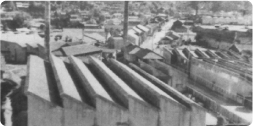
Nakashichi Momen Factory
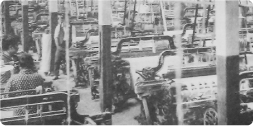
Inside of a weaving factory

Former Asada Textile Industry Corp.
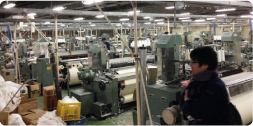
Okatoku Eastern Factory
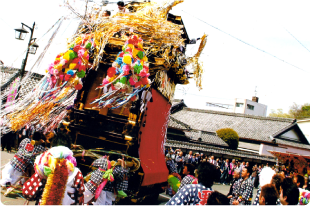

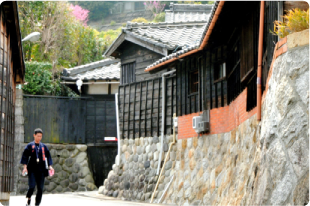
OKADA MACHINAMI PRESERVATIVE ASSOCIATION
This organization was established to protect the historical buildings and townscapes in Okada and contribute to regional development.
TEL・FAX 0562-56-4722(TIME 10:00 - 16:00)
< Office of OKADA MACHINAMI PRESERVATIVE ASSOCIATION > Momengura Chita: 9 Aza Nakatani OKADA, CHITA 478-0021
Take the Nishi-Chita-Sangyo Bypass. From the Nagaura Exit, 5 min to the east.
Or take the Chita-Hanto Bypass. From the Agui Exit, 10 min to the west.
From Asakura Station on the Meitetsu Tokoname Line, change to the Chita Bus.
From the Asakura Eki Mae bus stop, take the bus bound for Higashi Okada. Get off at the Okada bus stop.

Please come to the historical town of Okada in Chita City when you visit Aichi Prefecture.